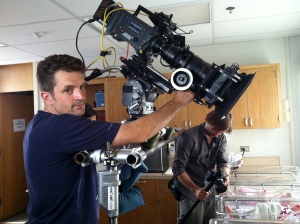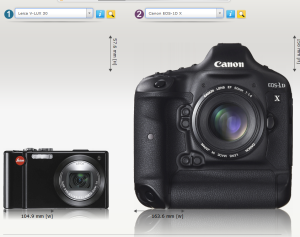This article is from my street photography blog, but I wanted to share on Berkeley Opinion as well as an ex-writer! Check out the full blog at phillipehan.wordpress.com or follow me on twitter @phantasyphoto!


SO YOU WANT TO BUY A NEW CAMERA.
Unfortunately, you’ve had the dismaying feeling of “There is no perfect anything” thrown at you one too many times. Fortunately for you, there is a camera that is “right” for you! Let me help narrow it down. You’ll eventually have to put the nail in the coffin for yourself: I’m not your mother or for that matter your unhygienic Best Buy employee trying to market a camera down your throat. Trust me, this is easier than it looks. Let’s stop and think about this question: Why are you so determined to buy that big new DSLR? Your point and shoot produces photos that can easily sate an annoying facebook girl’s latest obsession? You need to take prettier photos of your girlfriend? You’re determined to shoot fascinating landscapes that will make every lady swoon? Fear not, we’ll find the right one for you
THINGS TO FRET OVER, BITE YOUR NAILS, SQUIRM NERVOUSLY ABOUT, etc. : 
Weight- This is big. Do you mind that your shoulder aches after about 2 hours of shooting? Or is hurling around Big Bertha your thing? Read on.

Size- Another physical trait– do you care whether it fits into your backpack? Your luggage? Your handbag? Your man-purse? Your jean pocket?

Image Quality- Look at the two pictures on the top. Can you tell the difference in quality between the right and left? If not, good news– you won’t have to shell out another $1000 to satisfy your ravenous appetite for megapixels. If you do, then, well let's just say you're burning a bigger hole in your pocket. Lens– Yes, you have to buy a separate lens. No, they are not cheap (depends on your budget), but it’s these lenses, NOT the cameras themselves that determine the quality of your picture! I can’t emphasize this enough. So I’ll stop here. THINGS YOU MUSN’T WORRY YOURSELF WITH: Megapixels– No, really. Trust me, this means nothing past 10 megapixels, unless you have a fashion shoot with Vera Wang next week, (Which, if you do, count me in). Touch Screen/Swivel Screen- If anything, this sucks up your batteries. The larger the screen is not necessarily the better for two reasons: a) you waste time ogling your picture (called “chimping”) or b) your are unhealthily addicted to the latest technologies– neither of which really assist your photographic skills. So no, I don’t care if it’s made of OLED, I really don’t. Megapixels on your Touch Screen- Don’t start, now. Color– Unless you tend to discriminate severely between black and grey. Now that we’ve made some things clear, let’s start figuring out who you are. But consider this first:

1. the iPhone Statistically speaking if you’re reading this, you have a 40% likelihood that you already own this little guy– and this has more computing power than the entire NASA supercomputer campus combined from 1969. Combined with a reasonable camera (8 megapixels! for iPhone 4S), apps that you can get for free (Instagram or Camera+ for $0.99) can get you phenomenal results and its way better for keeping quiet and unnoticed on the streets. With a little bit more (Snapseed, for example) you can make fantastic results. There are some serious photographers out there now making movies and taking pictures quite seriously, for instance at iPhoneography (www.iphoneography.com). But let’s say that still doesn’t satisfy you, let’s consider the first “real” option:

2. the DSLR The DSLR (Digital Single Lens Reflex) camera market has matured to a point that these things are dirt cheap. Why? Because they’re heavy! No one wants to lug these around when there are smaller alternatives that are “good enough”! But don’t be fooled, the image quality of these DSLRs are noticeably better than those of the new, trendy cameras, which we’ll get to later. Moreover these things are big– as in if you’re paranoid enough to not allow your DSLR to hang on your café chair, and instead place them on the table, they’re going to be an unwelcome guest. No, they won’t fit in your pocket.
 But
But
The image quality is fantastic. The above image shows “bokeh,” an important concept that basically boils down to “the main subject being in focus and the background being out of focus.” This is called having a shallow depth of field. Is this what you want? Then you’re going to want a DSLR.
Recommendations: *Note: I’ve only used Canon so I can’t give an accurate picture of what Nikon, Sony, or Pentax are like. You can ask your fellow Nikon/Sony/Pentax geek about that, but at the beginner level, DSLRs don’t vary that much (in fact, if it does a lot, that’s a sign it’s trying to sell you bells and whistles you probably don’t need)
“I’m an absolute cheapie, not sure if I’m interested in photography” -The Canon Rebel XS (literally the cheapest DSLR out there): Currently at about $370, combined with the Canon EF 50mm f/1.8 II lens at about $90 = $460.
“I’m serious and want serious results.” -Above Canon XS, or Canon T2i* at $500 plus the Sigma 30mm f/1.4 lens at $490 will run you about $1000. OR Nikon alterative: -Nikon D7000 at $1100 with a Sigma 30mm f/1.4 lens at $470 is $1570. *Yes the T3i is the newest, but it’s actually worse in terms of image quality. Newer isn’t always better!
“I’ve been interested for a while and care to invest more. Like, playboy more.” -Canon 60D at $900 with the Canon 35mm L f/1.4 at $1300 = $2200. With that, let's move on to:

3. Micro Four-Thirds (aka m4/3, MFT) This is the newest group of cameras. Marketed as half the weight and size of DSLRs while maintaining DSLR-level image quality. That’s only partially true, look at this:

As you can see the “APS-C” labeled sensors are used by DSLRs, which gather the light to form your picture. The “Four Thirds” systems is anywhere between 40~60% smaller in surface area, so it gathers that much less light. So in reality you’re getting a slightly better deal in terms of weight, but you’re sacrificing a bit of image quality (grainier, blurrier)– still much better than a point-and-shoot you carry though (the smallest 1/2.5” sensor). But it's much larger than your regular point and shoot:

Left: Your average point and shoot sensor; Right: Spanking new Micro Four-Thirds.
Are you willing to make that sacrifice? If earlier you couldn’t tell the difference in quality between the two pictures, you’re in luck– there are some fascinating cameras being made out there. One important thing to know: ALL micro four-thirds cameras have the same mount. This means that regardless of whether the lens is made by Panasonic, Olympus, or Leica, the lenses work on any M43 body! Neat!Recommendations:
“Cheapie” Either the Olympus E-PL1 at $270 or the Panasonic Lumix GF3 at $500, with the Panasonic Lumix 20mm f/1.7 at $450-ish = $700~950!!! Yes M43, while compact and “good enough” in image quality, it’s still expensive!
“Intermediate” Panasonic GX1 at $700 with the Leica 25mm f/1.4 lens at $650= $1350.
“Playboy” Olympus OM-D/E-M5 at $1000, with the Leica 25mm lens above = $1650. 4. Boutique/Other Mirrorless
Simply put, can’t be thrown into a category on its own. These are all expensive, but if you’re serious about street photography the money is worth dropping into the bucket. “Playboy” Ricoh GXR with 28mm f/2.5 unit = $1000. “Investment Banker” Fujifilm X-Pro 1 with the 35mm f/1.4 lens for a total of $2300(!!). Or Sony NEX-7 at $1200 with a Sony 16mm F/2.8 at $330 = $1530. “Startup CEO” Leica M9. Enough said.
4. Boutique/Other Mirrorless
Simply put, can’t be thrown into a category on its own. These are all expensive, but if you’re serious about street photography the money is worth dropping into the bucket. “Playboy” Ricoh GXR with 28mm f/2.5 unit = $1000. “Investment Banker” Fujifilm X-Pro 1 with the 35mm f/1.4 lens for a total of $2300(!!). Or Sony NEX-7 at $1200 with a Sony 16mm F/2.8 at $330 = $1530. “Startup CEO” Leica M9. Enough said.
5. Film There is always this option =) I will talk about this in a different article!
Other tips:
-Don’t look at just one website– Amazon isn’t always the cheapest. I recommend B&H Photo, and try comparing things against each other on Google Shopping.
-Don’t, under any circumstances, use a zoom lens. It will bring you blurrier photos and force you to re-consider your purchase. Instead, I recommend the lens pairings above, or at least anything fixed-focal length (28mm, 35mm, 50mm). Zoom lenses also make you fall into a bad habit of relying on the lens to “get closer,” when in reality you should be framing the scene by walking towards and away from your subject. This means avoiding any “bundle” or “kit” lenses companies try to sell you. Trust me, avoiding this bad habit will save you between 300 to 600 dollars of pure agony.
Any cameras I missed? Disagree with my choices? I could be wrong you know. Enter your comments below to let me know! As always, follow me @phantasyphoto on twitter, add me on 500px, or like my facebook page to stay updated with the latest… well, updates. &Phil
Edit: I recommend against the Nikon V1/J1 series & Samsung cameras. Although marketed as Micro-Four-Thirds, their lenses are absolutely horrible.
Edit 2: I bought and used the Fuji X100 for a year, and after its horribly slow autofocus and unusable manual focus, I traded it away for a film camera.
'EDITORIAL > 과학 :: Science & Tech' 카테고리의 다른 글
| 휘어진 사과 心 (6) | 2014.10.02 |
|---|---|
| 원자력 발전의 잠재적위험; 핵폐기물 (2) | 2013.04.08 |
| 비타민(Vitamin), 알고 먹자! (1) | 2011.11.22 |
| 페이스북은 우리에게 약인가 독인가? –나는 사람 냄새가 그립다 (0) | 2011.11.09 |
| 2번이나 노벨상을 수상한 라이너스 폴링을 아시나요? (1) | 2011.08.17 |





